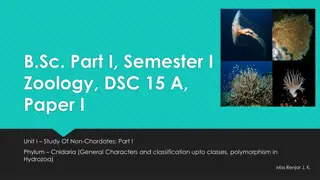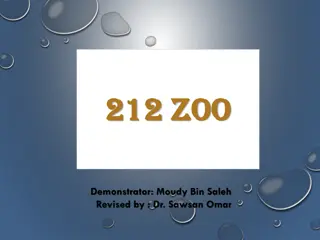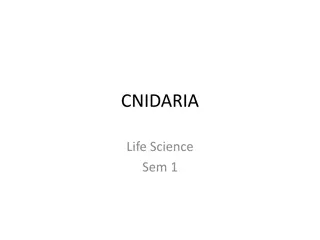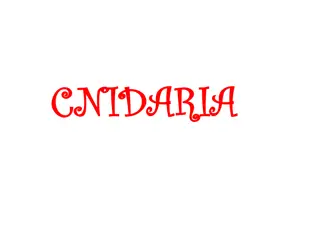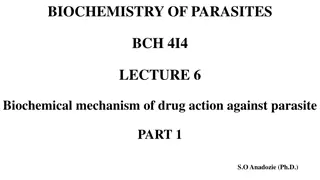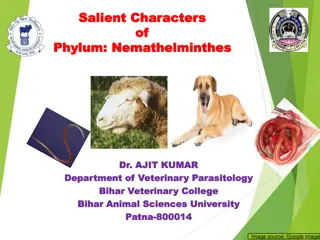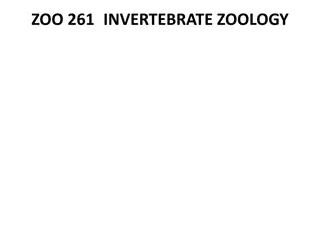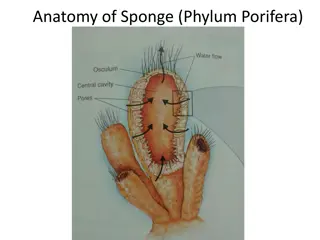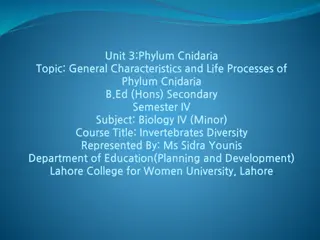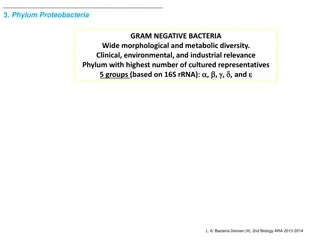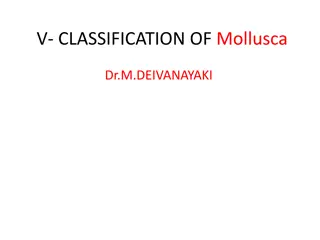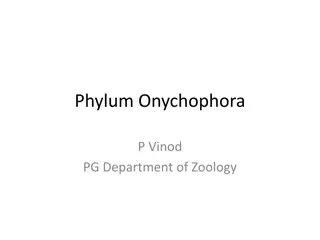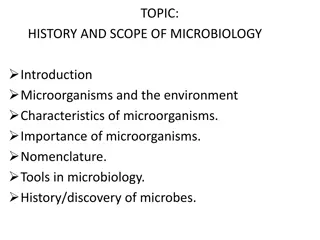Classification and Characteristics of Phylum Protozoa
Phylum Protozoa comprises unicellular, microscopic, eukaryotic organisms found mostly in aquatic habitats. They exhibit diverse locomotory structures such as cilia, flagella, or pseudopodia. These protists may possess a cellulose cell wall and various membrane-bound organelles like mitochondria and chloroplasts. Protozoans display different modes of nutrition and store reserve food materials such as glycogen and fat. Reproduction in this phylum can be sexual.
Uploaded on Sep 13, 2024 | 0 Views
Download Presentation

Please find below an Image/Link to download the presentation.
The content on the website is provided AS IS for your information and personal use only. It may not be sold, licensed, or shared on other websites without obtaining consent from the author. Download presentation by click this link. If you encounter any issues during the download, it is possible that the publisher has removed the file from their server.
E N D
Presentation Transcript
ZOOLOGY DEPARTMENT F. Y. B. Sc. Practical's Prof.Ughade P.K. 1
Index 1. To study the classification with reasons of the following- PhylumProtozoa-Amoeba, Euglena and Volvox. PhylumPorifera-Sycon, Hyalonema and Euspongia 2. To study the classification with reasons of the following- PhylumCoelenterata-Hydra, Physalia, and any one Coral PhylumPlatyhelminthes-Tapeworm, Planeria, Liver fluke 3. To study the classification with reasons of the following- PhylumAschelminthes-Ascaris PhylumAnnelida-Tubifex, Leech and Neris 4. Culturing of Paramoecium 5. Study of live Paramoecium 6. Study of external characters, binary fission and conjugation in Paramoecium 7. Study of external characters and digestive system of earthworm. 8. Study of reproductive system of Earthworm.
9. Study of Nervous system of Earthworm. 10. Earthworm mounting- Septal nephridia, setae and Spermatheca. 11. Study of Prokaryotic and Eukaryotic cell with the help of suitable material. 12. Study of temporary preparation of different mitotic stages from Onion root tip cells. 13. To study the classification with reasons of the following- Hemichrdata- Balanoglossus Urochordata- Doliolum/ Salpa Cephalochardata- Amphioxus 14. To study the classification with reasons of the following- Cartilaginous fishes- any two Bony fishes- any two Amphibia- any three 15. Study of External characters, sexual dimorphism and digestive system of Frog. 16. Study of Brain of Frog.
17. Study of monohybrid ratio and dihybrid ratio providing hypothetical data and deducing applicability of Mendelian laws 18. Preparation of culture media and maintenance of Drosophila culture 19. Study of Drosophila: External characters and sexual dimorphism 20.Study of Drosophila mutant (any 2 eye and wins mutant). 21. Study of genetic trait in human being (tongue rolling, widow s peak, ear lobe, color blindness and PTC tester/ Non-tester) 22. Study of normal human karyotype from metaphase chromosomal spread picture. 23. Study of blood group in human. 24. Study of any 3 cell organelles. 25. Compulsory visit to Vermiculture unit/ biodiversity spot/ ZSI/ large water body.
Practical No. 01 To Study the Classification with reasons of the following- PhylumProtozoa-Amoeba, Euglena and Volvox. PhylumPorifera-Sycon, Hyalonema and Euspongia
A) Phylum Protozoa- General Characters- These organisms are unicellular, Eukaryotic, microscopic and mostly aquatic. Some are terrestrial. They are either motile or non- motile. Locomotory organs are Cilia, Flagella or Pseudopodia, etc. The protist with or without cell wall. If cell wall is present, it is made up of cellulose. They have membrane bound cell organelles such as mitochondria, Chloroplast, ER, Golgi complex. The nucleus is well organized i.e. with nuclear envelope, nucleoplasm, nucleolus, and DNA. They show Photosynthetic, holozoic, saprophytic or parasitic mode of nutrition. The reserve food material is in the form of glycogen or starch and fat. Reproduction is sexual or asexual. E.g. Amoeba, Diatoms, etc.
1. Amoeba Systematic position- Phylum- Protozoa (Microscopic and unicellular) Class- Rhizopoda (Locomotory organ are Pseudopodia) Order- Lobosa (Pseudopodia is lobose or filose, Ecto and Endoplasm distinct) Family- Amoebidae Genus- Amoeba Species- proteus
2. Euglena Systematic position- Phylum- Protozoa (Microscopic and unicellular) Class- Mastigophora (Locomotory organ are Flagella) Order- Euglenoidina (Body is covered with soft and rigid Pedicle) Family- Euglenaceae Genus- Euglena Species- gracilis
3. Volvox Systematic position- Phylum- Protozoa (Microscopic and unicellular) Class- Mastigophora (Locomotory organ are Flagella) Order- Phytomonadina (Oval or elongated flagella enclosed in semi cellulose memb.) Family- volvocaceae Genus- Volvox Species- carteri
B) Phylum Porifera General Characters- These aquatic mostly marine and few freshwater. They are multicellular organisms. They are sessile, solitary and conical. Surface of body is perforated by large pores. Number of pores and canal present. Body is symmetrical or radially symmetrical. Body wall is diploblastic. Nervous system is absent. Sponges passes great power of regeneration. E.g. Sycon, Euspongia, etc.
1. Sycon Systematic position- Phylum- Porifera (Pore bearing) Class- Calcarea (Endoskeleton consist of calcareous spicule) Order- Heterocoela (Canal system is syconoid type.) Family- Sycettidae Genus- Sycon
2. Hyalonema Systematic position- Phylum- Porifera (Pore bearing) Class- Hexactinellida (Skeleton consist of triaxon, six- rayed Siliceous spicule) Order- Amphidiscophora (Spicules are Amphidiscs, No Hexasters) Family- Hylonematidae Genus- Hyalonema Species- calix
3. Euspongia Systematic position- Phylum- Porifera (Pore bearing) Class- Demospongae (Canal system is leuconoid type) Order- Dictyoceratida Family- Spongidae Genus- Euspongia Species- officinalis
Other examples of Phylum Protozoa and Porifera Trypanosoma Plasmodium Staurocalyptus Barrel sponge 20



